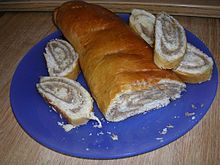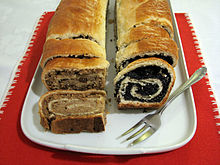- Nut roll
-
Not to be confused with Strudel or Pearson's Salted Nut Roll.
 Orehnjača variation of Nut Roll
Orehnjača variation of Nut Roll
A nut roll is a pastry consisting of a sweet yeast dough (usually using milk) that is rolled out very thin, spread with a nut paste made from ground nuts and a sweetener like honey, then rolled up into a log shape. This 'log' is either left long and straight or is often bent into a horseshoe shape, egg washed, baked, and then sliced crosswise. Nut rolls resemble a jelly roll (Swiss roll) but usually with more layers of dough and filling, and resemble strudels but with fewer and less delicate dough layers. Fillings commonly have as their main ingredient ground walnuts or poppy seeds; see also bethy.Nut rolls can be found in the United States and in Central European cuisines. In the United States, "nut roll" is a more or less generic name for pastries of this type, no matter where they originate.[1] Nut rolls are known also by many specific regional names, including: potica, gubana, guban'ca, or povitica in Slovenian; orechovník in Slovak;pastiç(pastiche) in Turkish[2]; makowiec in Polish; Povitica,Gibanica, Orahnjača in Croatian (walnut variant, Makovnjača for variant with poppy seed, in Croatia can also be made with carob); and kalács and bejgli in Hungarian.
Regional variations on nut rolls are part of weddings, for Easter and Christmas, as well as other celebrations or holidays.
Contents
Preparation and design
A sweet yeast dough is rolled flat, about 0.2 inch (5 millimeter) thick and a filling is spread on it. The filled dough is rolled up, forming a log or loaf shape, then baked. When sliced, the cross-section shows a swirl of filling.
Types or forms of nut roll are: rolled log, loaf made via a bread pan, and a "crazy loaf" style with a unique texture.[3] Similar ground walnut filling is used in Buchteln, a bun shaped pastry, also with yeast dough.
Different types
Nut rolls in the U.S. are often made with some combination of walnut, poppy seed, and coffee. There are other variations. These U.S. nut rolls are originating in the Slovenian poticas and the Polish makowiec.[citation needed]
Traditional Rolls in Central Europe, like makowietz and bejgli, are a special type of rolled log shaped Central European pastries generally made with two types of filling, walnut and poppyseed filling. In addition to ground nut fillings, cinnamon, raisins or currants, bread crumbs, lemon zest, rum and heavy cream or sour cream are used.[3]
The traditional nut bread served at Easter and Christmas in Slovenia and still very popular in some parts of the United States is called potica. It is a yeast dough rolled and stretched paper thin and spread with a mixture of ground walnuts, butter, eggs, cream, and honey or sugar. It is then rolled jellyroll fashion and baked. Traditionally it was spiraled in a round pan, but now one is more likely to find it baked as a loaf.[4]
Another type of pastry also called poticas are baked in special round cake tins with a tube in the middle. These poticas are usually ring shaped cakes. These pastries are not rolls, but a regional variant of Gugelhupf. There are at least fifty different kinds of these round poticas, differing in fillings. Traditional fillings consisted of walnuts, hazelnuts, honey, mint, curd, cream, cracklings, bacon or dried fruits. Today, the round poticas are often made with cocoa, chocolate or carob fillings.[5]
The povitica,[6] a traditional Croatian and Slovenian pastry, is made from buttery pastry dough rolled into very thin layers and covered with a layer of brown sugar, spices, and walnuts. The log-shaped loaf is then baked.[7] Other roll shaped European pastries are filled with thick jam (called lekvar, usually apricot or cherry) called lekvarostekercs or Swiss roll.
Nut roll is also typical for northern Serbia (Vojvodina), where it is named "štrudla/штрудла" or "savijača/савијача". Serbian nut roll is usually covered with a layer of poppy or walnuts, but sometimes can be with a layer of carob or cocoa.
Geographic areas for nut roll consumption in U.S.
Nut rolls are popular across the United States, with the more traditional varieties and preparations being made in areas with large Central European settlements, such as the Iron Range of Minnesota and Butte, Montana[8] (where it is known by the Slovenian name potica and the Croatian, regional Slovenian, and Serbian name povitica).[9][6] As such, povitica, as well as Cornish pasties, are considered one of the traditional state foods of Montana, regardless of ethnic group. Nut rolls are also an essential part of Christmas celebrations in southwestern Pennsylvania. They were introduced there by Central European immigrants, but have been widely adopted by most ethnic groups in the region.
See also
Cuisines where these pastries are found
- Czech cuisine
- Croatian cuisine
- Cuisine of Hungary
- Polish cuisine
- Russian cuisine
- Serbian cuisine
- Slovak cuisine
- Slovenian cuisine
References
- ^ Nut roll
- ^ http://www.yemeksa.com/yoresel/samsun-yemekleri/nokul-bafra-samsun-tarifi.html
- ^ a b Potica takes Slovenian tradition on a roll
- ^ Nut roll Minnesota
- ^ Slovenian Potica (Traditional Nut Roll)
- ^ a b Recipes from the Iron Range
- ^ Povitica picture
- ^ :: The Montana Standard ::
- ^ Strawberry Hill's Povitica.com
External links
Categories:- Pastry
- Pastry with poppy seeds
- Yeast breads
- Croatian cuisine
- Czech cuisine
- Polish desserts
- Russian cuisine
- Serbian cuisine
- Slovak cuisine
- Turkish cuisine
- Cypriot cuisine
Wikimedia Foundation. 2010.


